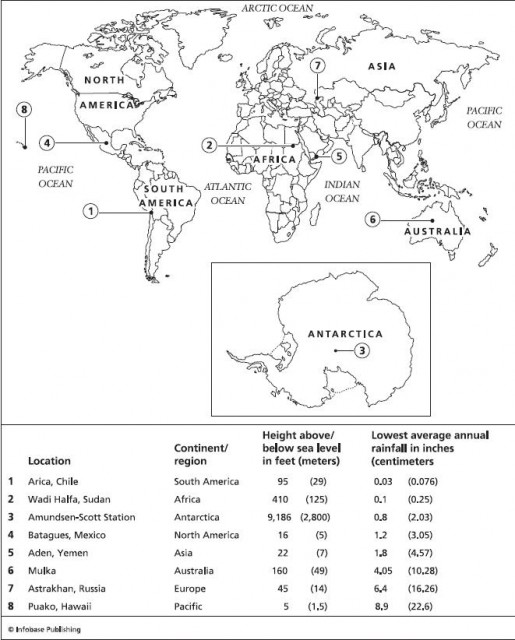A Landscape of Sand
The great, flat sandy plains separating both the volcanic mountain ranges and the uplifted plateaus dominate most of the Arabian Desert. Covered with rocks or gravel fitted into something of an armor plating by the patient actions of wind and frost, these desert pavement surfaces protect the dry, sandy soil beneath. Some of the plains are covered with a saltbased crust known as duricrusted soil. This salty crust also prevents the frequent winds from picking up the dry sand that is largely unanchored by plant roots. Other areas are dominated by gravel plains, covered with interlocking pebbles and chips of chert washed down onto the plains during the wet Pleistocene epoch (1.8 million to 10,000 years ago). Only dry washes that hold water during the rare storms remain in this desert, but these wadis follow the ghostly path of great rivers that flowed during the ice ages, when this desert was a grassy plain with scattered trees much like the areas of southern Africa where scientists believe our ancestors evolved following great herds of animals. Several of the river deltas left by these vanished systems are as large as the current delta of the Nile River. These traces of vanished rivers testify to the startling realization that most of the deserts of the world are surprisingly young, including this one surrounding the cradle of civilization.
Today, this network of dry wadis is just a ghostly memory of those great river systems, but they remain vital to the history and ecology of the Arabian Desert. Only one of the region's drainage systems carries water year-round, the network of wadis and tributaries that feed into the Tigris and Euphrates rivers and the Wadi Hajr in the south.

The region also has some strange geological features, like the sabkhah, or saline flat, that forms along the coast where the repeated advance and evaporation of the sea has left a concentration of salty, mineralized brine just below the surface. This salty crust reaches a thickness of perhaps three feet (1 m), interlaced with layers of mud and other sediments like gypsum. An innocent-looking layer of sand may cover these dangerous layers of salty slush. But an unwary traveler can suddenly break through this thin crust of normal sand and find himself floundering in deep layers of gooey, silty muck with the consistency of custard.
The desert also harbors great dune fields, which come in every shape and size and form a complex, constantly shifting topography. One dune field in the Al-Nafud covers 25,000 square miles (65,000 sq km). An even larger dune field, the Rub' al-Khali, covers 250,000 square miles (650,000 sq km). Some of these dunes reach heights of 300 feet (91.4 m), high enough to bury a typical American city without leaving a trace. Some of those dunes take forms unique to the Arabian Desert, including a giant crescent-shaped dune with a steep slope that moves constantly, with a hollow in the arms of the crescent that reaches bedrock so that from the air the dune looks like a giant hoof.
The single most barren and desolate area is called Rub' al-Khali, the Empty Quarter. It covers an area larger than France in the southern part of Saudi Arabia and over into the borders of Oman and Yemen. Even the desert-dwelling Bedouins, whose caravan routes have crisscrossed this desert for centuries, rarely venture into the waterless Rub' al-Khali.